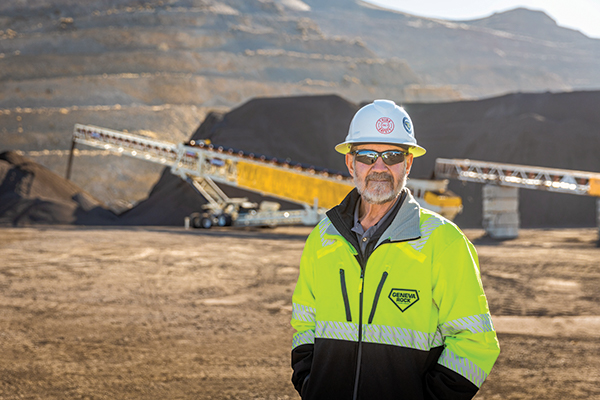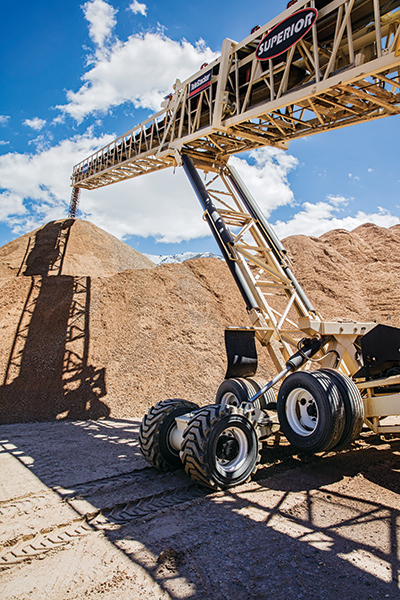Getting the most out of any material handling system

Ed Clayson, aggregates production manager
at Geneva Rock, has more than 45 years of industry experience. Photo: Superior Industries
Achieving peak efficiency levels is an everyday feat of engineering and teamwork at the Geneva Rock Products Point-of-the-Mountain site near Salt Lake City.
The facility has long been lauded for its commitment to sustainability, energy savings and safety. The commitment is illustrated by a unique energy-generating downhill overland conveyor system that was commissioned more than five years ago.
This much-touted material handling system (which, according to the company, paid for itself in under three years) transfers up to 3,000 tons of material per hour from a mountain of upper-ledge rock to ground-level processing operations – while generating enough electricity to power the entire facility.
Most folks would say Geneva Rock has reached its peak performance, but the company continues to climb higher with ongoing improvements to each circuit and system, as well as to every transfer point, belt, pulley, idler and more.
For Geneva Rock, truly mastering peak efficiency is all in the material handling details.
Desegregated recycle stockpiling

Prior to the use of the TeleStacker, Geneva Rock utilized a standard radial stacker. Photo: Superior Industries
One of the facility’s most recent upgrades was revamping material handling methods in the asphalt recycling operations.
When specifications for the use of recycled asphalt became far more stringent in Utah, the operation needed to avoid segregation not only in the materials, but also in the oil content of the recycled asphalt.
“When the rules of the game change, we need to change with them,” says Ed Clayson, aggregates production manager at Geneva Rock who has more than 45 years of industry experience.
Clayson’s company consulted with Superior Industries, a single-source provider of aggregate processing equipment and material handling systems and components.
“Superior Industries had designed and manufactured our downhill overland conveyor, which has performed flawlessly since we put it into operation,” Clayson says.
Superior recommended the use of a 36-in. x 150-ft. TeleStacker conveyor, a telescoping radial stacking conveyor that eliminates material segregation by stockpiling materials in windrows to ensure the stockpiled material meets specifications.
“There is quite a variance in the oil content between the chunk asphalt and the milled asphalt that’s hauled into our facility for recycling,” Clayson says.
Prior to using the TeleStacker, Geneva Rock used a standard radial stacker to stockpile recycled asphalt. Then, it would try to blend the material with the use of a dozer.
Even with added material handling, there was too much discrepancy in the specs.
“The TeleStacker has eliminated these costly issues as we introduce the material back into our HMA plant,” Clayson says. “We’re getting more uniform gradations in our pile and have not had any specification issues to date. Due to the way the unit is programmed, we get a much better blend of material, and the product is the same on one end of the pile as it is on the other.”
Latest design advancements

In working with Superior Industries, Ed Clayson feels Geneva Rock is at an advantage because the company designs and builds both the conveyor systems and the components. Photo: Superior Industries
Superior designed and manufactured its telescopic radial stacker in 1997, and feedback from the field over the years led to a number of innovations in its design.
“The latest design advancements to the TeleStacker conveyor make it the best value for the money,” Clayson says.
Clayson’s team particularly likes the new FD auto level technology, which automatically maintains a level head pulley while in radial travel mode. This is an important factor because an uneven conveyor structure is one of the leading causes of belt mistracking on radial telescopic conveyors.
“In the location where we’re stockpiling, it’s not like we can build a concrete pad or runway to keep it perfectly level,” Clayson says. “So the auto-leveling feature is a really big deal that ensures the integrity of the belt and structure.”
Equally important is the addition of a material flow sensor – the SonicScout material sensor – that causes the telescopic conveyor to stop radial travel should there be a stoppage in feed material.
“With recycle, there is often some contamination in the material that may stop material flow,” Clayson says. “If there is no feed material hitting the conveyor, the sensor causes the conveyor to stop its travel, preventing the potential of gaps in the stockpile.”
According to Clayson, the unit’s PilePro automation program is user-friendly, easy to operate and easy to troubleshoot via one call to Superior’s in-house automation team. The zoning technique of the program allows Geneva Rock to build a higher-volume stockpile on a limited footprint.
“We need to stockpile as much as we can in our designated area,” he says. “In the winter, we’ll build a 30,000-ton stockpile that will feed the asphalt plant all summer long.”
The components

The PilePro program offers a zoning technique for those with tight footprints. Photo: Superior Industries
In working with Superior, Clayson feels Geneva Rock is at an advantage because the company designs and builds both the conveyor systems and the components.
“We maintain a large inventory of their pulleys and idlers,” Clayson says. “Over the years, they have delivered significant cost-per-ton savings due to increased wear life and belt protection.”
Superior is also providing custom idlers for Geneva Rock in a few locations.
“We have two existing overland conveyors built by other conveyor manufacturers, and the components on them do not offer the quality we require,” Clayson says. “To eliminate the potential of costly downtime and belt damage, we are changing out the idlers on those conveyors with the custom components provided by Superior.”
To Clayson, the best solutions include the support that comes with the equipment Geneva Rock buys. Kimball Equipment provides that to the company.
“I’ve learned over time that you can’t do this by yourself,” Clayson says. “Having the right solutions and the right support makes us successful.”
Carol Wasson is a veteran freelance writer for the aggregate and construction equipment industries.









